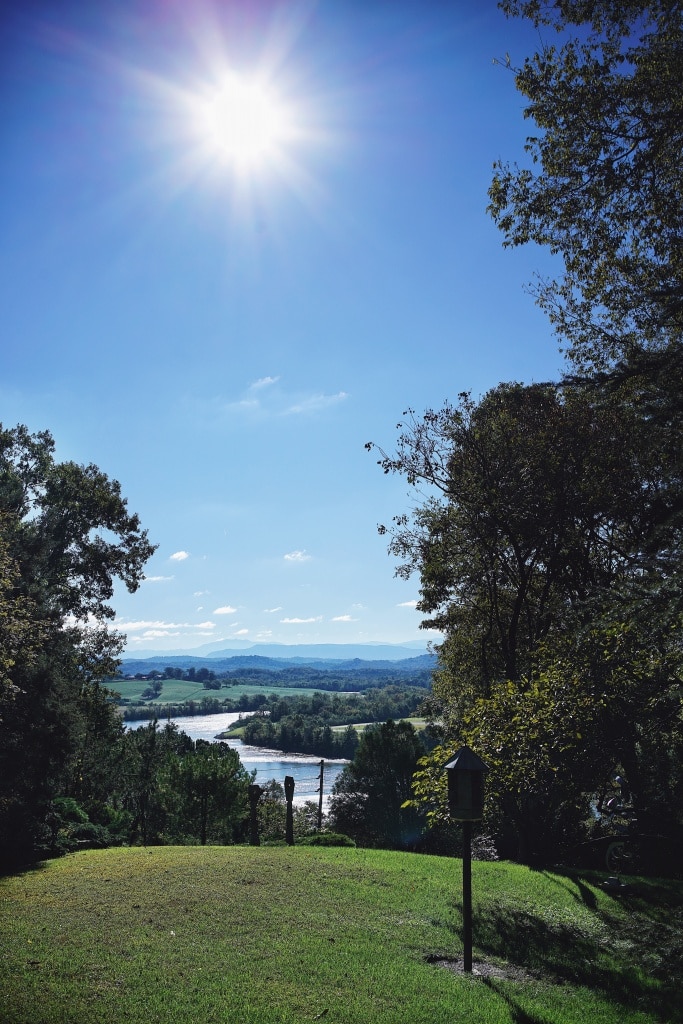Experience wonder, peace and tranquility in the private gardens of Dr. Alan Solomon
By Amelia Bartlett

Walking through its winding paths, you’ll meet over 350 varieties of conifers, myriad ponds and micro-ecosystems and spirited structures that make the property seem infinite. Amassing 20 acres a mere three miles from downtown Knoxville, you feel instantly transported to another realm when you step through the gates.
Dr. Alan Solomon moved to Knoxville nearly 50 years ago to accept a teaching position at the University of Tennessee Graduate School of Medicine, an appointment that was supposed to last just two years. Hailing from New York, the oncologist fell for East Tennessee’s natural splendor and wide-open spaces, though, and he found himself purchasing the first parcel of his now-famed property after a short stint in West Knoxville, completely unaware of what his legacy would behold.
When Solomon first acquired the property, he had little experience working with the land and possessed no knowledge of gardening, stonemasonry or landscaping. What he did have, however, was a knack for making friends.
The names of his lifelong collaborators aren’t etched in history, but their legacies are woven into the roots of what is dubbed God’s Answer to Our Prayers.
Marvin Franklin, an electrician at UT Hospital, would spend his Saturdays teaching Solomon to lay stone. Carl Wallace, a local landscaper, regularly took his crew to the property and is responsible for much of the layout and structural definition of the gardens.
“What we do is let the land talk to us [and] tell us what to do,” Solomon says, “Rather than telling the land what to do.”
Meandering down stone pathways, running your hands along wrought-iron handrails and breathing the fresh morning dew perched upon the grass, it’s practically unimaginable that most of the work you see was done by hand. However, Knoxville’s hilly terrain and the property’s complex structure made it nearly impossible to bring in heavy equipment. But that didn’t stop Solomon from spending more than half his life with his hands in the dirt.
“At the end of the traditional workday at the hospital, it’s hard to know what you’ve done,” he says. “With gardening, you can see something – anything – that you’ve accomplished. That’s satisfying.”
Just when you think you’ve fully settled into the quiet rhythm of the garden, an enormous frog statue, sitting lazily on a bench, winks through the glinting sunlight. Sitting next to a small rocky waterfall, his grin invites you to sit, and you lose track of time.
The word that comes to mind as you move deeper into the garden is ‘spirituality.’ All over the property are places in which to sit: benches or smooth rocks where you can stop, rest and contemplate in silence, enjoying the birds chirping and the wind humming.
“We really had no plans,” Solomon says of the layout strategy. “You just find a spot that needs something and then work with that.”
It’s hard to believe that an endeavor so massive – a 20-acre, thoughtfully landscaped ecosystem containing three houses and the leftover monument of a marble quarry – could have been sculpted without any blueprints. But, as Solomon reminds me, a sense of optimism goes a long way.
“With just a single person, you can do only so much,” he says. “But with another person, you can do so much more.”
Even without experience, Solomon treated “each day as a gift” and listened to what the land asked of him. He’s laid hundreds of tons of stone, foraged local wildflowers for transplant into his property and learned many lifetimes over the wisdom of the earth. He attributes much of his success, though, to the generosity and multi-decade camaraderie of his friends.
“We’ve had the same lunch every Friday for more than 40 years,” he says.
Every Friday morning, Solomon assembles kosher hot dogs and beans, letting them simmer for three to four hours. At lunchtime, he breaks out a casserole dish and serves them with sauerkraut, mustard, pickles, potato chips, Coca-Cola and chocolate-chip cookies. He estimates he’s cooked more than 8,000 hot dogs over the construction of God’s Answer to Our Prayers.
When you reach the grassy expanse at the lowest valley in the garden, take your shoes off. It’s the softest grass you’ve ever felt between your toes. The trees stretch high above you, but there’s at least 100 feet until the next stone installment. Take off in a run, and feel the ground beneath your feet.
So many times, Solomon begins a sentence with, “I’m so lucky, so fortunate,” and even if you spend just a few minutes with him, you know: Fortune favors the kind, the brave and the ready. The good doctor is all of those things and more.
Solomon’s legacy of kindness and optimism is infused in every inch of God’s Answer to Our Prayers. There still are unfinished edges, and even as he sits healing from an injury, he can’t wait to get back out to lay more stone.
At fewer than 10 acres, the property started out as the homestead of Lloyd and Virginia Pease, who, when moving to Knoxville, each held a prayer in their hearts. One prayed for a home that overlooked the mountains; the other prayed for a home that overlooked the water.
There once was an 8-year-old boy who visited a rural farm for the first time in 1941. That little boy said to himself, “When I grow up, I’m going to live in a place where the house is made of wood. There will be a lot of dogs running around, and I’m not going to be able to see anyone.”
God’s Answer to Our Prayers continues to give, and its legacy will live on in Knoxville, forged by the sweat of Dr. Alan Solomon’s brow and the memory of his dearest friends.






